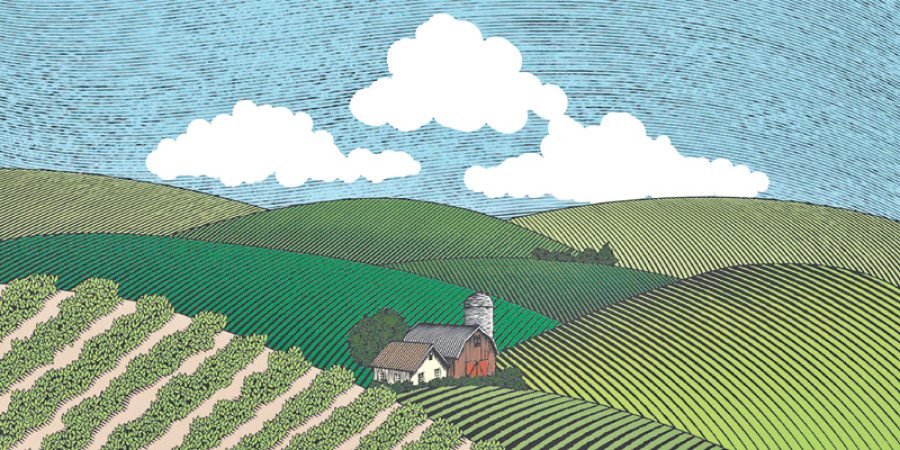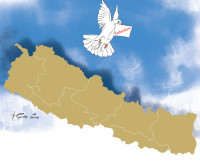Opinion
Time to change
The government needs to give emphasis to mechanised agriculture to attain agricultural development
Kshitij Adhikari & Sagar Kafle
More than seven billion people in the world rely on food grown on just 11 percent of the global land surface. Day by day, the fertile agricultural lands are being turned into concrete in the name of development. Rapid population growth with a demographic decline of farmers has always posed a challenge to food security. According to the World Bank, about one percent of agricultural land and about two percent of forest land has decreased since 2000. Since land availability is decreasing, the only way to meet the food requirement is by increasing food productivity and leaving the land fallow for shorter periods by adopting multiple cropping approaches. In Nepal, the tradition of dividing the land among the sons results in small and marginal farms, restricting the use of large farm machineries.
The import of agriculture products in Nepal is growing every year. In the last six fiscal years, the share of the import of agriculture products on total imports increased by almost six percent. This calls for small, efficient and affordable machineries to replace the traditional less efficient equipment used in our agricultural sector.
This does not mean that only mechanical power is the means to mechanise the agriculture sector. Mechanisation can also take place with the help of improved manually-operated and animal-drawn equipment. The constraints, advantages and criteria to use different forms of power inputs—human, animal, self-propelled and electricity-operated—only need to be understood better. Farmers need to select equipment and implements as per their requirements.
Selection criteria
Manually-operated equipment is suitable when the plot size is comparatively small, the topography uneven and the availability of human labour adequate. On an average, it is seen that only 50 square meter of area is covered by a person in an hour while performing intercultural operations manually. The area can easily be doubled using improved tools such as a cono weeder and a wheel hoe weeder, which operate manually with little effort.
Tractors and power tillers are known as mechanically powered farm machineries and are widely used all over the world. Farmers are attracted to power tillers and tractor operated equipment due to their ease of transportation, operation and cost-effectiveness. Further, these machines can be attached with ploughs, till-plant machines, cultivators, levelers, puddlers, reapers, weeders, threshers, water pumps, tuber crop diggers, and trolleys. Another important factor that makes power tillers popular is their weight—they range from 50 to 100 kg, making them portable on the narrow and sloppy terraces in the hills and mountains of Nepal. The versatility of these machines increases the annual use period, thereby making them more cost effective and efficient.
On the other hand, we know that the different agricultural operations performed by animals are limited to two to three months a year, but animals still need to be fed throughout the year. It is difficult to use animal power for other purposes besides tillage and transportation. This leads to decreased utility of these animals and reduced economic viability. An increase in the annual use of available animal power sources through improved equipment for farming operations may improve the livelihood of farmers.
Way ahead
Emphasis should be given on machines and equipment for improving productivity in horticulture and animal husbandry, as well as for enhancing production, preparation and distribution processes. Keeping in view the indispensability of animal power in the prevailing agro-climatic and socio-economic condition of the country, the government should also lay emphasis on the promotion and popularisation of improved hand tools, animal drawn implements and some electricity-operated machines among the farmers. Identification of the specialised agricultural equipment suitable for catering to the needs of different regions and formulating long-term mechanisation strategies of each agro-climatic zone is a must for agricultural development. Promotion of these proven technologies
should take place through different organisations and the agricultural extension offices. The government should study the role of agricultural machinery in agricultural development in many other developing countries and implement policies on farm mechanisation. Long-term institutional development with the vision to provide training facilities to young and progressive farmers may bring substantial change to the current agricultural scenario of the country.
Adhikari is a Farm machinery engineering graduate and Kafle is a Horticulture and Biosystems engineering graduate from Kangwon National University, South Korea




 17.12°C Kathmandu
17.12°C Kathmandu


.jpg&w=200&height=120)







%20(1).jpg&w=300&height=200)

